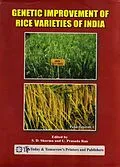The book covers almost all the fields of agricultural research on rice such as morphology, taxonomy, origin, antiquity, physiology, genetics plant breeding, agronomy, soil science, entomolgy, pathology, agricultural engineering, economics and marketing in India up to the present time but highlights the work done during the last forty years in India. The chapters have been especially written for readers who have graduated in agricultural sciences and have no specialisation on the subject covered in chapter. The book is expected to serve as a reference book for teachers and students of state agricultural universities, extension workers working in the state departments of agriculture, organisations dealing with seeds, fertilisers, pesticides, herbicides, etc. It will also serve as a handy reference book for rice researchers who seek precise and updated information on their lateral disciplines. experts who have worked for more than thirty years in their respective fields in national institutes or state agricultural universities have contributed the chapters. The editors have long years of experience on rice research in the Indian agricultural research system. Each of them has contributed many research papers in their respective fields and has contributed chapters for scientific books.
Autorentext
Dr. Shatanjiw Das Sharma had his post-graduate education in Genetics and Plant Breeding at Indian Agricultural Research Institute, New Delhi during 1958-1964. He started his career as Assistant Geneticist at the Central Rice Research Institute, Cuttack (1964-1968), then served as associate Professor at Govind Ballabh Pant University of Agriculture and Technology, Pantnagar (1967-1968), as Botanist (Rice) at Regional Station of the Indian Agricultural Research Institute at Hyderabad (1968-1976), as Senior Scientist (Genetic Resources) at International Institute of Tropical Agriculture, Ibadan, Nigeria (1976-1979) and as Head of the Regional Station of National Bureau of Plant Genetic Resources at Shimla (1976-1982). From 1982 till his retirement (in 1994) he worked as the Principal Scientist and Head, Division of Genetic Resources at the Central Rice Research Institute, Cuttack. After his retirement, he was a Distinguished Fellow of the M. S. Swaminathan research Foundation, Chennai for seven years and was responsible for successful implementation of some of the international projects on documentation and conservation of genetic resources in Orissa. Dr. Sharma has published more than 50 research papers in various scientific journals and presented about 15 papers in various national and international scientific meetings and symposia. He has contributed chapters on conservation of genetic resources of rice and on wild rice in many books. Dr. Sharma is an authority on conservation of genetic resources of rice in India and an international authority on wild species of Oryza. recently, Dr. J. S. Nanda and Dr. S. D. Sharma have jointly edited Monograph on Genus Oryza published by Scientific Publishers Inc, Enfield (NH), USA. An Indian edition of the book has also been brought out by Oxford & IBH Publishing Pvt. Ltd. Dr. Sharma's residential address: Dr. S D. Sharma, C-4, Sai Tower, Nayapally, Bhubaneswar - 751012, Orissa, Email: s_d_harma@yahoo.com and sdsctc@rediffmail.com
Klappentext
The book is an updated version of Rice in India(1960) and rice Research in India(1985) published earlier by the Indian Council of Agricultural Research> The book covers almost all the fields of agricultural research on rice such as morphology, taxonomy, origin, antiquity, physiology, genetics plant breeding, agronomy, soil science, entomolgy, pathology, agricultural engineering, economics and marketing in India up to the present time but highlights the work done during the last forty years in India. The chapters have been especially written for readers who have graduated in agricultural sciences and have no specialisation on the subject covered in chapter. The book is expected to serve as a reference book for teachers and students of state agricultural universities, extension workers working in the state departments of agriculture, organisations dealing with seeds, fertilisers, pesticides, herbicides, etc. It will also serve as a handy reference book for rice researchers who seek precise and updated information on their lateral disciplines. experts who have worked for more than thirty years in their respective fields in national institutes or state agricultural universities have contributed the chapters. The editors have long years of experience on rice research in the Indian agricultural research system. Each of them has contributed many research papers in their respective fields and has contributed chapters for scientific books.
